
Overview
Alaska Power & Telephone Company (AP&T), which started in Skagway, Alaska in 1957, is celebrating its 50th anniversary as an employee-owned company this year. From humble beginnings offering standard hard-wire telephone service in Skagway alone, AP&T now offers a sophisticated range of energy and communication services to its customers.
In an era where much focus is placed on cutting-edge communication technologies, AP&T has quietly forged a leadership role in the field of renewable resource energy, unique in a state that where most financial and energy interests are dominated by petroleum-based mega-corporations.

AP&T is on the forefront of the green movement in the power generation industry. The Washington-based company has shifted its carbon footprint enough to relegate the role of diesel generation to “back-up” duty in just over a decade. Just twelve short years ago, AP&T generated 99 percent of its energy using fossil fuels. Today, renewable-based resources generate 70 percent of that energy. AP&T views the remaining 30 percent as motivation to pursue further advances in alternative energy sources.
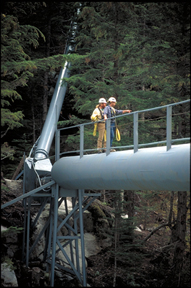
Recognized as one of the most progressive utilities in Alaska, AP&T’s continued success lies primarily in the employee-owned company’s willingness to promote and develop long-term reliable energy and communication solutions while capitalizing on the innovation and technical expertise of its personnel.
In the past five decades, a growing demand for energy coupled with oil prices at record levels created an evironment ripe to diversify the way energy in Alaska is produced. Since 1957, AP&T has grown from serving one community to more than thirty-three, with the number of households and businesses served climbing from a handful to over twelve thousand. The number of employees has increased from nine to 134, 28 of whom are full time employees in Port Townsend, Washington. AP& T serves an area spanning from communities above the Arctic Circle, to deep in the Wrangell Mountains, and throughout the islands of Southeast Alaska.
“This has been a fascinating five decades, with ups and downs, challenges and achievements,” said Stan Selmer, previous chairman of the employee-owned company. “The technologies have changed and many of the names and faces have changed. But there have been two constants: Our commitment to having the best people doing right by the customers and communities we serve, and our firm belief in the power of innovation.”

Seeking Alternatives
AP&T’s commitment to innovation is best illustrated by what it has accomplished in the last decade in its power generating division. “Any time a company can migrate the impact of their fossil fuel generation to the extent AP&T has in the previous 12 years, you have to say that people are interested in hearing.,” said Selmer. “Twelve years ago, 99 percent of the energy we produced came from fossil fuels. Today, of our production is renewable-resource based. That transformation has a twin benefit -- to the environment and to our customers because it improves our efficiency and effectiveness.”
Geography and climate also make AP&T unique among the nation’s power and telecommunications companies. “We’ve created power systems on hard-to-access, icy mountaintops and repaired phone lines on storm-battered islands,” said Selmer. “What some people might consider above and beyond, AP&T people view as ordinary.”
Most of Alaska cannot geographically be connected by an electrical grid. Therefore, each community (or small groups of rural communities) must create the energy needed by its residents. The state cannot purchase low cost energy because Alaskans are not electrically connected to the lower 48 states. Though most states have only a few electric utilities serving the entirety of each state, in rural Alaska, 86 utilities serve 181 communities.

The majority of energy generated in rural Alaska uses isolated diesel generators. In 1957, the year AP&T began, the cost of a barrel of oil was approximately three dollars. In August of 2007, that same oil sells for $74 per barrel. This price difference is what gave AP&T the impetus to look for alternatives to diesel generation.
Hydroelectric Opportunities
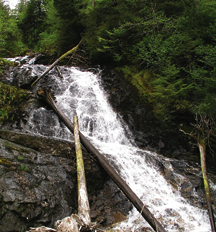
Alaska is rich in water resources. Looking toward water as a solution to Alaska’s energy needs was an obvious and logical choice. In a state where resources are big business, AP&T decided to harness some of those same resources to provide reliable energy to its customers. Some might argue that the capitol costs of these undertakings are too high. The payoff comes from lessening the need for expensive and, at times, unpredictable fuel sources.
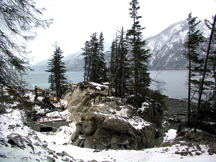
AP&T has more hydroelectric projects on line, under construction and in the planning stages than any other investor-owned utility in Alaska. “Research, design and advancement of sites conducive to environmentally sound renewable resource energy is a primary focus,” said AP&T’s President Robert Grimm. “It’s important as Alaskans, and as a society, that we leverage practical renewable resource opportunities in ways that minimize our threshold of greenhouse gas emissions in the field of energy production.”

The company’s first completed major hydroproject was the Black Bear Lake (BBL) Project on Prince of Wales Island in Southeastern Alaska. At the time of its licensing and construction, the Black Bear Lake Hydro Project was the most ambitious project in AP&T’s company history. Completed in 1996 with total project costs of approximately ten million U.S. dollars, the plant utilizes an alpine lake with a surface area of 215 acres for seasonal storage, rather than a dam. Energy is created using a siphon and penstock flowing to the power generation structure below. The project has a drainage basin of 1.8 square miles and provides most of the power for Prince of Wales Island. BBL Hydro is rated as a 4.5 Megawatt project with the lake spill elevation at 1,687 feet.
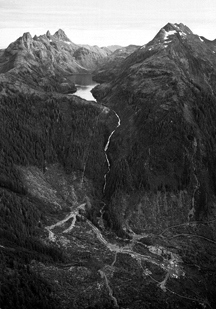
The Black Bear project was the first low impact environmental certification awarded by The Low Impact Hydropower Institute (LIHI) in Alaska and has earned national recognition for its “low-impact” on the environment. To earn certification, the Black Bear Lake Project was required to meet the following eight rigorous low impact criteria set forth by LIHI: water quality, fish passage and protection, river flows, watershed health, endangered species protection, cultural resources, recreation use and access, and whether or not the dam structure had been recommended for removal.

The institute’s certification program was designed to help consumers identify environmentally sound, low-impact hydropower facilities for emerging “green” energy markets. Included among those currently serving as governing board members for LIHI are Ashok Gupta of the Natural Resources Defense Council, Nicole Silk of The Nature Conservancy and Robbin Marks with American Rivers.
AP&T’s second major hydroelectric project is the Goat Lake Project, located near Skagway. The 204-acre glacially fed lake has the winter storage necessary to sustain year-round hydro generation. Also certified as low impact by LIHI, Goat Lake became operational in 1997 and was connected with Haines via a 15-mile submarine cable in September 1998. The submarine cable was laid in Taiya Inlet, a fjord with depths up to 1,500 feet. This 4.0 MW plant serves the communities of Haines and Skagway via a 35 KV submarine cable placed in the Upper Lynn Canal, the frigid body of water that connects the communities. This project allowed diesel-powered generators at both the Skagway and Haines plants to be quiet for the first time in nearly 80 years. Both of these projects required coordinating, educating and maintaining local support from business leaders, native corporations and residents as well as state and federal agencies.
AP&T has other operational hydro-projects running and in planning and construction phases. In fact, in 1909 at the site of AP&T’s original location in Skagway, a small hydroelectric plant was built. That plant is still in operation today as the 943 KW Dewey Lakes Hydro project and has been run by AP&T since 1957.
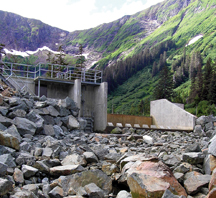
Other projects included the South Fork Project, a 2 MW run of river that works in tandem with Black Bear Lake to supply power to Prince of Wales Island. South Fork came on line and began providing power in December of 2005. The Kasidaya Creek Hydroelectric project, an expected 3 MW run of river located between Skagway and Haines, will begin producing power in spring of 2008. In addition to its Alaskan hydroelectric facilities, AP&T is a partner in the Pasabien hydroelectric project in Guatemala.
The continued quest to harness renewable resources is a mix of modern technology, environmental priorities and the ability to tackle complicated engineering problems. AP&T works with landowners, federal and state management and resource agencies, consumers and local government to offer safe, reliable and reasonably priced electric power.
Diesel-powered generation systems remain a long-term reality in some of the company’s remote areas. It is possible that hydropower will eventually replace or supplement to an even greater degree the current reliance on fossil fuels.
Alternative Power Generation
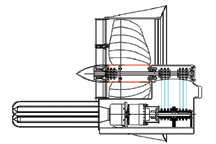
AP&T now has the first, second and only hydro sites in the State of Alaska with the green low-impact certification on their energy projects. Other measures are being taken to further lessen the company’s carbon footprint. AP&T is building a low-impact renewable energy system using “Run of River” technology on the Yukon River. Designed to serve customers in the City of Eagle and nearby Eagle Village, the pilot study will test the feasibility of utilizing river turbine technology to supplement or supplant existing diesel generation in rural Alaska. This is part of AP&T’s plan to ensure long-term energy service and reliability for rural Alaskan customers.

The Eagle project will be the utility’s first venture into the innovative field of river turbines. The 100-kilowatt “hydrokinetic” river turbine will be powered by the Yukon’s powerful current. The cutting-edge technology relies on a low impact turbine that is adaptable to a variety of locations where sufficient flow of current is available.
Every winter, the Yukon River freezes solid for several months. Immersed in the current, the turbine will operate until just prior to the spring ice break-up of the river. At that time, a hole would be cut in the ice and the turbine will be lifted from the water and taken ashore for annual maintenance. Once cleaned and maintained, the turbine will be repositioned for another year of operation when the river is clear of the huge and powerful chunks of break-up ice. Potential obstacles to maintenance-free operation could come from sooner-than-anticipated wear caused by excessive abrasion from silt or vegetation debris.
While discussing while discussing the minimally invasive environmental impact the project will have, lead project engineer Ben Beste noted that photographs taken before and after construction would be almost identical. That is the kind of footprint AP&T is aiming for – power generation without disturbing the natural world Alaska provides.
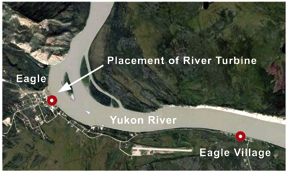
The energy needs for the town of Eagle fluctuate between 7kW and 170kW. If this pilot project is successful, the installation of two turbines would virtually supplant the need to run diesel power generation for both Eagle and Eagle Village. The river turbine equipment under consideration for use has a rating of 100kW and is manufactured by the UEK Corporation of Maryland. Very little data exists worldwide on the feasibility of like projects.
It is expected evaluations of the River project will provide information on using the technologies for broader applications elsewhere. The anticipated payback of the unit is ten years. Nobody knows for sure what the actual life expectancy of these types of units is. Therefore, a portion of the project’s intrinsic value is building the knowledge base associated with their operation.
The Future of Green Energy
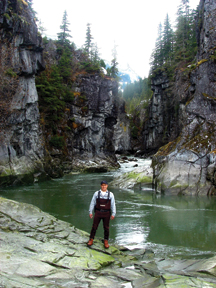
“To take a leadership role in the development of new technologies is a natural extension of our vision as an employee-owned company and a practical opportunity to minimize our threshold of energy production related greenhouse gas emissions in the field,” said APC President Robert Grimm.
For many years, the demand for cheap energy has put natural resources at risk. With the increasing price of fuels and the increasing need for energy, AP&T is putting fifty years of effort in the generation industry toward finding better ways to do business and serve customers.
Serves areas spanning from communities above the Arctic Circle, to deep in the Wrangell Mountains, and throughout the islands of Southeast Alaska. APT is committed to maintaining its legacy of a half-century of innovation and reliability, while developing long-term renewable energy and communication solutions that capitalize on the expertise of its skilled employee-owners.
For more information, go to www.aptalaska.com. For more information on the LIHI institute, go to www.LowImpactHydro.org
About the Author
Amanda Kelly covers oil and gas industry topics for local and national publications. A graduate of Salem State College in Massachusetts, Kelly has completed programs for writers at Harvard University, Bennington College and the University of Washington and is a member of the Pacific Northwest Association for Women in Communications and Digital Eve. She lives in Seattle, Washington.







